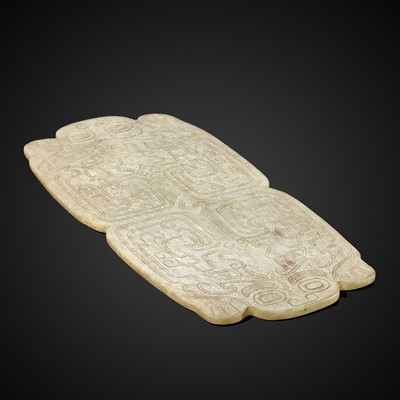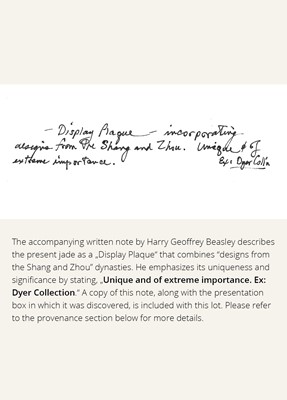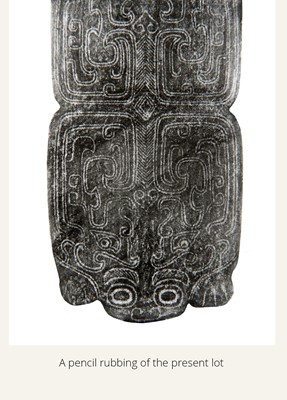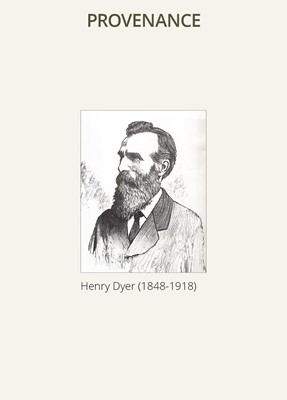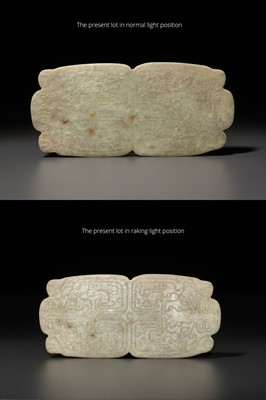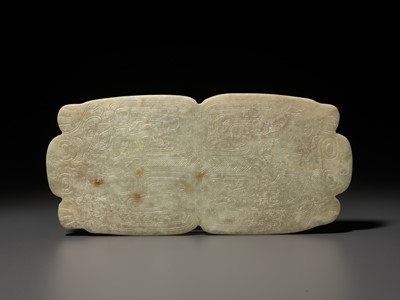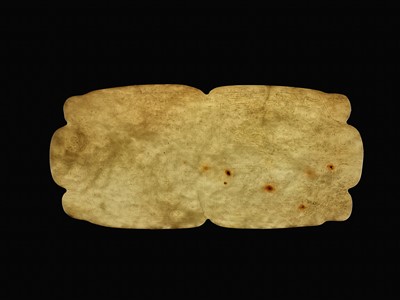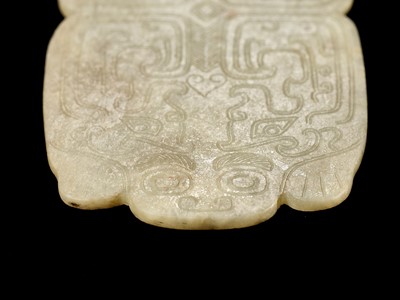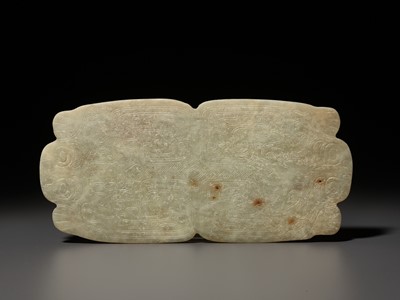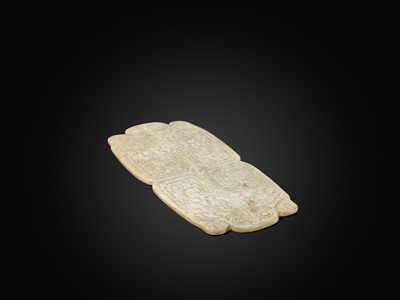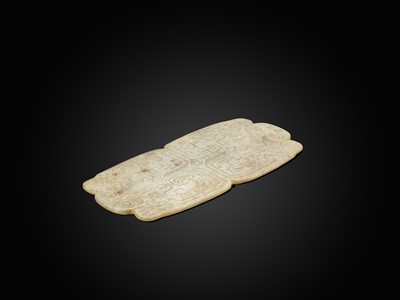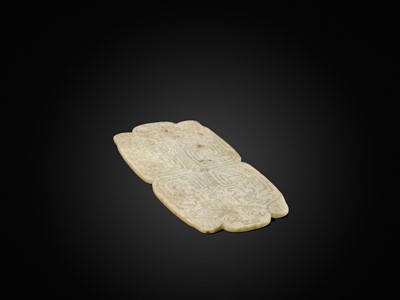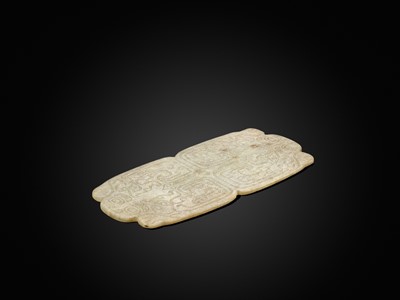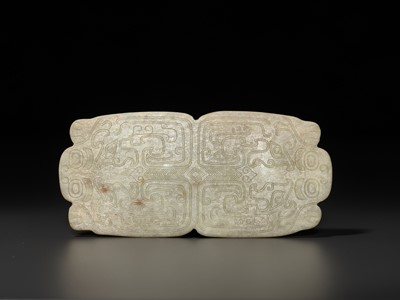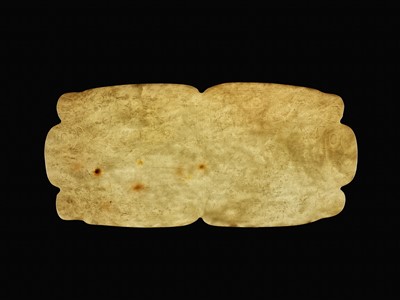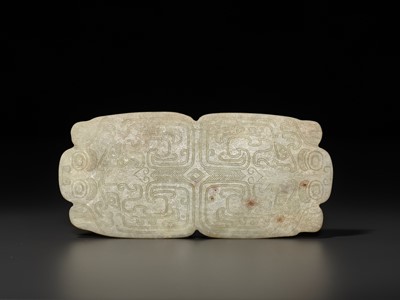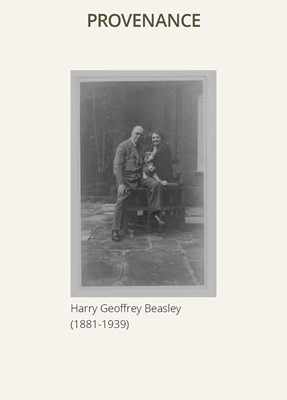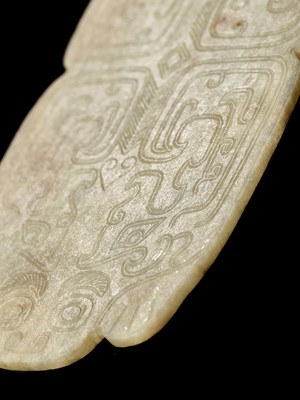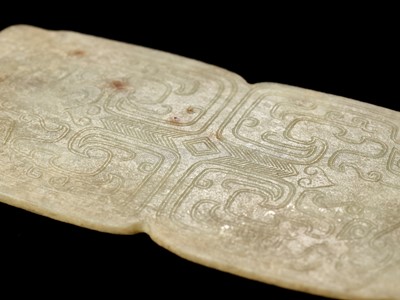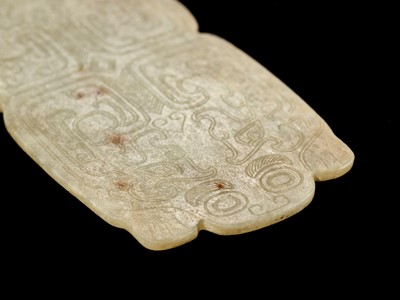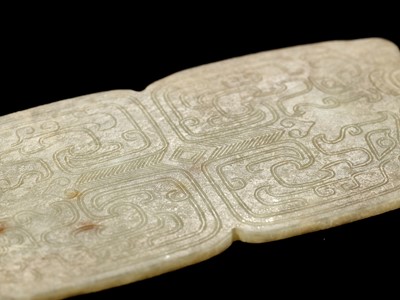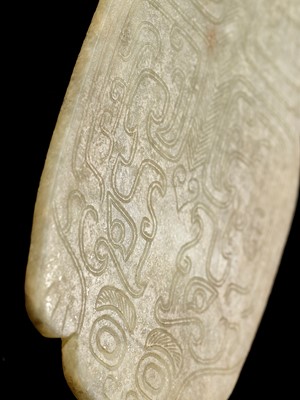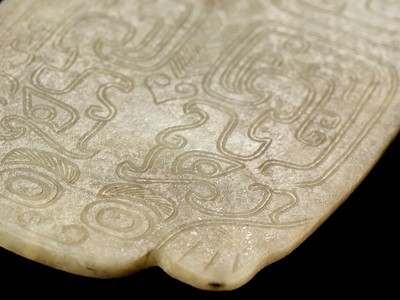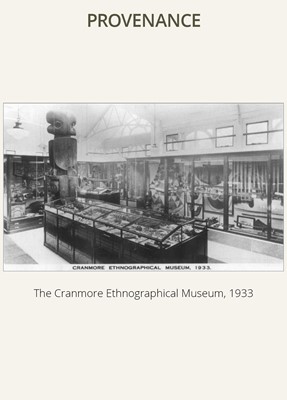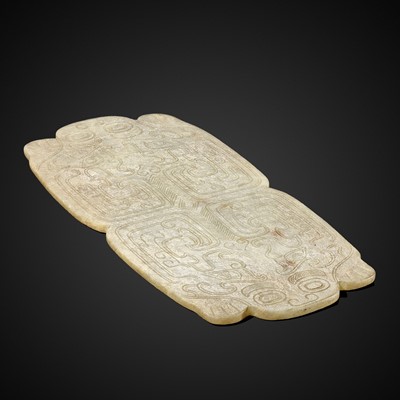1st Mar, 2024 10:00
The No Reserve Dragon Sale
66
AN IMPORTANT YELLOW JADE ‘DOUBLE-BEAR’ ORNAMENTAL SEAL AND RITUAL PLAQUE, SPRING AND AUTUMN PERIOD, CHINA, CIRCA 770 TO 481 BC
春秋時期重要雙熊紋玉牌,西元前約770-481年
Sold for €10,400
including Buyer's Premium
Please note this Lot is to be sold at No Reserve. 本拍品不設底價
Expert’s note (part I): This exceptional jade plaque, distinguished by its remarkable preservation and rarity, encompasses the craftsmanship styles of both the Shang and Zhou dynasties, as aptly noted by Harry Geoffrey Beasley in his commentary on this artwork a century ago (refer to provenance section below). It stands as an extraordinary testament to the legacy of the Spring and Autumn era. With a prestigious history, it was initially held in the esteemed collection of Henry Dyer, a renowned engineer and collector from Glasgow, Scotland, who was awarded the Order of the Rising Sun by Emperor Meiji. Subsequently, it found its place in the museum of Harry Geoffrey Beasley before eventually becoming part of the family collection of Alfred William Cowperthwaite in 1939. In terms of quality and condition, this jade plaque ranks alongside the finest surviving archaic jades in the rich history of ancient China.
The accompanying written note by Harry Geoffrey Beasley describes the present jade as a "Display Plaque" that combines designs from “the Shang and Zhou” dynasties. He emphasizes its uniqueness and significance by stating, "Unique and of extreme importance. Ex: Dyer Collection." A copy of this note, along with the presentation box in which it was discovered, is included with this lot. Please refer to the provenance section below for more details.
The plaque is entirely flat and exhibits meticulous carvings on both sides, portraying two crouching bears positioned back to back. These bears are intricately rendered with emphasized facial features and paws, all finely incised in deep and high relief. Additionally, the plaque is adorned with two stylized dragons on the back of each bear, accompanied by skillfully executed geometric designs. These designs are masterfully crafted using adjacent double- and single-line grooves, enhancing the overall aesthetic appeal of the piece.
The absence of any drilled holes or natural openings that would allow suspension leaves no doubt that this plaque was not intended to be worn merely as a piece of jewelry or an ornamental item, neither during one's lifetime nor in the afterlife. Instead, it was specifically crafted as a ceremonial centerpiece, likely revered and utilized in rituals spanning generations. It probably also served as a seal plaque and was ultimately interred alongside a significant noble leader. The substantial size of 12.8 cm further supports this evaluation.
The translucent stone is of a beautiful pale yellow tone with faint green hues and a few distinct russet spots. Calcification throughout.
Provenance:
-Henry Dyer (1848-1918), according to a copy of a handwritten note written by Harry Geoffrey Beasley found inside a presentation box, which was custom made for the present lot by the orders of Alfred William Cowperthwaite. Most likely acquired by Henry Dyer during his stay in Japan from 1873 to 1882, where he was awarded the Order of the Rising Sun, the highest Japanese honor available to foreigners, by the Emperor Meiji.
-Harry Geoffrey Beasley (1881-1939), acquired from the above, probably after Dyer’s death in 1918.
-Irene Beasley, widow of Harry Geoffrey Beasley, by descent in 1939.
-Alfred William Cowperthwaite (1890-1964), acquired from the above in 1939 or shortly thereafter.
-Thence by descent within the Cowperthwaite family to the last owner.
Condition: Very good condition, commensurate with age. Wear, minuscule nibbling, signs of weathering and erosion, encrustations, all consistent with an extensive time of burial. Calcification throughout.
Weight: 54.9 g
Dimensions: Length 12.1 cm
Please click here to read the full description
With an old presentation box and glass cover. (2)
Henry Dyer (23 August 1848 – 25 September 1918) was a noted Scottish Engineer and collector of Asian art. He is principally remembered for his contributions to curriculum development for the Imperial College of Engineering of the Meiji government of Japan, aimed at creating young Japanese engineers of various industrial fields to achieve rapid modernization. Dyer designed a six-year academic curriculum which was a revised version of the Royal Indian Engineering College curriculum adapted to Japan's specific scientific and technical needs. To provide practical training, Dyer helped set up the Akabane Engineering Works, the largest in the whole Empire of Japan. Many of the major engineering works carried out in Japan at the end of the 19th century were by his former students. When Dyer left Japan, Emperor Meiji awarded him the Order of the Rising Sun, the highest Japanese honor available to foreigners. Returning from Japan, Henry Dyer brought back various artifacts and works of art, some of which were later donated by his descendants to the Mitchell Library in Glasgow, and Edinburgh Central Library. A number of East-Asian musical instruments from his collection were lent to the National Museum of Scotland in 1906 and eventually bequeathed in 1937. There are also 199 East Asian works of art in the Special Collections section at The Mitchell Library, mainly composed of objects from the Henry Dyer Collection. Two archaic jades originally coming from the Dyer collection and then in the Yumi Zhai Collection were sold by China Guardian in 2017.
Harry Geoffrey Beasley (1881-1939) was a British anthropologist and museum curator who developed an important ethnographic collection during the early 20th century that is now held in various British museums. With his wife Irene, Beasley set up the Cranmore Ethnographical Museum which eventually held more than 6,000 objects of ethnographical interest. The Beasleys collected objects from across Europe, buying from auction houses and local museums to expand the collection, which contained material from the Pacific, Asia, Africa, and Northwestern America. Beasley wrote numerous articles for anthropological journals and was considered an expert in his field. He died in 1939 and his collection was stored with the British Museum collections during the war, which was fortunate as the Cranmore Museum was destroyed by bombing. After the war substantial portions of the collection were passed to the British Museum, the Royal Museum in Edinburgh, the Museum of Archaeology and Anthropology, the University of Cambridge, the Pitt Rivers Museum, and the Merseyside County Museum. Other pieces, such as the present lot, were sold by his widow and, after her death in 1974, by their daughters.
Alfred William Cowperthwaite (1890-1964) was a contributor to the Cranmore Museum and became good friends with Harry Beasley. Shortly after Harry Beasley’s death, he acquired a number of objects from Irene Beasley, including the present lot.
Expert’s note (part II):
The Spring and Autumn period was a time in Chinese history from c. 770 to 481 BC which corresponds roughly to the first half of the Eastern Zhou period. The period's name derives from the Spring and Autumn Annals, a chronicle of the state of Lu, which tradition associates with Confucius (551–479 BC). While the aristocracy of the Western Zhou frequently interacted via the medium of the royal court, the collapse of central power at the end of the first half of the Zhou dynasty left in its wake hundreds of autonomous polities varying drastically in size and resources, nominally connected by bonds of cultural and ritual affiliation. During this specific period, smaller noble lineages sought to enhance their cultural and ritual influence by adopting a symbolic representation reminiscent of the once powerful Eastern Zhou or Shang dynasties. The current jade serves as a compelling testament to these efforts.
Notably, the plaque's capability to also function as a seal, making an imprint of remarkable clarity and thus leaving a lasting impression, speaks volumes about its significance. The earliest known examples of seals in ancient China date to the Shang dynasty (c. 1600 – c. 1046 BC) and were discovered at archaeological sites at Anyang. However, how exactly these ancient seals were used remains to be uncovered, because it is only from the Spring and Autumn period (771–476 BC) onwards, that there is an increase in the quantity of seals paired together with textual references to them.
The Chinese employed leather, fabric, bamboo, wax, clay, pottery, and even bronze to imprint symbolic representations during the 1st millennium BCE. However, these materials were either too ephemeral, heavy or expensive for widespread use. Consequently, finding completely flat and even jade plaques from this period that show raised decorations suitable for imprinting them onto another media is exceedingly rare. Only the adoption of paper in the 1st century AD opened the door to the development of widespread printing technology. The present artifact thus also holds historical value as evidence that advanced imprinting methods were already present half a millennium earlier.
It is possible that another purpose of the motifs on the present plaque was to imprint the designs with washable dye, or blood, on the skin of human participants during ritual ceremonies or similar occasions. However, it is important to note that no historical evidence has definitively confirmed such a practice in ancient China to date. While the speculation exists, further research and documentation are required to establish the existence of this particular usage.
In the realm of early Chinese art, animal motifs can be classified into two main categories: naturalistic and highly stylized. Regardless of the style chosen, the artists of these works consistently demonstrate a profound connection and intimacy with the depicted animals. It is worth noting that the presence of these animal representations may or may not convey religious connotations or symbolic meanings. Therefore, delving into the significance of these images can provide insights.
The animal motifs found in early Chinese art can encompass depictions of fantastical creatures derived from imagination, as well as representations of real-world animals, or a combination of both such as found in the present lot. In either case, these motifs represent an innovative configuration within the context of archaic ritual art. When a jade object featuring an animal motif was purposefully designed and created, its intention was to provide a specific visual experience that would have been understood by the viewer.
In instances where real animals are portrayed in a naturalistic manner, their realistic features are always prominently displayed. This deliberate emphasis suggests that the objects themselves where meant to be imbued with a sense of animated power, affirming the viewer's existing knowledge and relationship with these animals. Overall, the use of animal motifs in early Chinese art reveals the cultures’ profound connection and understanding of the animal kingdom.
In ancient ancestral worship, wild animals including bear, tiger, and boar were admired for their strength and craftsmen were mesmerized by their resilience and shrewdness, inspiring them to carve exceptional objects. The present jade plaque has the stylized features of the crouching bears sensitively rendered with skillful incisions. The overall representation is abstract, with use of scrolling geometric motifs to convey the archaic design, but with key features including the paws, eyes, brows, nostrils and snarling expression naturalistically depicted.
Compare a closely related plano-convex jade plaque, 4.7 cm long, dated to the late 7th to early 6th century BC, in the National Museum of Asian Art, Smithsonian Institution, accession number S2012.9.1129, and another related plaque, which is completely flat, accession number S2012.9.1224. A plaque from the Song dynasty, smaller in size, embossed and carved in more detail, but with a somewhat diluted, less fundamental and strict symbolic language is in the same museum, accession number F1916.158.
Literature comparison: Related craftsmanship is evident on a Shang jade buffalo in the Harvard Art Museum, illustrated in Max Loehr and Louisa G. Fitzgerald Huber, Ancient Chinese Jades from the Grenville L. Winthrop Collection in the Fogg Art Museum, Harvard University, Cambridge, 1975, cat. no. 148. The majority of early jade animal depictions are two-dimensional plaques: see for instance the jade water buffalo in the Mrs Edward Sonnenschein Collection, Chicago, illustrated by Alfred Salmony, Carved Jade of Ancient China, 1938, pl. XXIII (8), and the example in the Arthur M. Sackler Gallery, illustrated by Jessica Rawson, 'Animal Motifs in Early Western Zhou Bronzes from the Arthur M. Sackler Collections', Chinese Bronzes: Selected articles from Orientations, 1983-2000, Hong Kong, 2001, p. 20, fig. 12.
点此阅读中文翻译 (Chinese Translation)
春秋時期重要雙熊紋玉牌,西元前約770-481年
隨附Harry Geoffrey Beasley的書面註釋將本件玉器描述為結合了“商周”時期風格的玉牌,他強調了它的獨特性和重要性,說道:“獨特且極其重要。來自Dyer收藏。” 此拍品中附有注釋複印件以及發現該注釋的盒子。請參閱下面的出處部分瞭解更多詳細資訊。
玉牌完全平坦,兩面分別雙線槽和單線槽陰刻兩隻背靠背蹲著的熊。熊的面部特徵和爪子雕刻入微,浮雕深淺不一。玉牌沒有鑽孔或自然開口,這塊玉牌不僅僅是作為一件珠寶或裝飾品佩戴,無論是在生前還是來世。相反,它是專門製作的祭典上的裝飾品。它也可能曾被用作印章,之後用於位重要的貴族的陪葬物品。12.8厘米的尺寸也支持了這一論點。
半透明的石料呈現美麗的淡黃色,帶有淡淡的綠色調和一些明顯的黃褐色紋理,整體鈣化。
專家注釋 (第一部分):這件精美的玉牌保存完好,非常罕見,展現了商周兩代的工藝風格,正如Harry Geoffrey Beasley 在一個世紀前對這件藝術品的評論中所恰當指出的那樣(請參閱下面的出處部分)。它是春秋時代遺產的非凡見證。最初由來自蘇格蘭格拉斯哥的著名工程師和收藏家Henry Dyer 收藏,他曾被明治天皇授予旭日勛章。隨後,它在 Harry Geoffrey Beasley 的博物館中佔有一席之地,最終於 1939 年成為 Alfred William Cowperthwaite 家族收藏的一部分。這塊玉牌可與歷史悠久的現存古玉雕相媲美。
來源:
-Henry Dyer (1848-1918), 根據一份盒子裏找到的Harry Geoffrey Beasley寫的信的複印件,這是根據Alfred William Cowperthwaite的訂單定制的。最有可能是Henry Dyer在 1873 年至 1882 年在日本時獲得的,當時他被明治天皇授予旭日勛章,這是日本向外國人授予的最高榮譽。
-Harry Geoffrey Beasley (1881-1939),購於上述收藏,可能是在Dyer1918年去世後。
-Irene Beasley, Harry Geoffrey Beasley的遺孀,1939年繼承。
-Alfred William Cowperthwaite (1890-1964), 1939年或之後購於上述收藏。
-在Cowperthwaite家族保存直至最後一任。
品相:狀況極好,有磨損、微小的磕損、風化和侵蝕的跡象、結殼,所有這些都與長時間的地下埋葬有關,鈣化。
重量:54.9 克
尺寸:長 12.1 釐米
玻璃蓋收納盒。 (2)
Henry Dyer (1848年8月23日 – 1918年9月25日) 是一位著名的蘇格蘭工程師和亞洲藝術收藏家,因其對日本明治政府帝國工程學院課程開發的貢獻載入歷史。該課程旨在培養各個工業領域的年輕日本工程師以實現快速現代化。Dyer設計了六年的學術課程,該課程是印度皇家工程學院課程的修訂版,適合日本特定的科學和技術需求。 為了提供實踐培訓,Dyer幫助建立了整個日本帝國最大的赤羽工程工廠。十九世紀末在日本進行的許多重大工程工作都是由他以前的學生完成的。當他離開日本時,明治天皇授予他旭日勛章,這是日本向外國人授予的最高榮譽。 從日本回來後,Henry Dyer帶回了各種文物和藝術品,其中一些後來由他的後代捐贈給格拉斯哥米切爾圖書館和愛丁堡中央圖書館。 他收藏的一些東亞樂器於1906年借給蘇格蘭國家博物館,並最終於1937年捐贈給該博物館。米切爾圖書館的特別收藏部分還藏有199件東亞藝術品,主要來自Henry Dyer收藏。 中國嘉德於 2017 年出售了兩件最初來自 Dyer 收藏、後來屬於 Yumi Zhai 收藏的古玉。
Harry Geoffrey Beasley (1881-1939) 收藏,他逝世後由其遺孀Irene Beasley保存;Alfred William Cowperthwaite (1890-1964),約於1939年購於上述收藏,之後在同一家族保存至今。Harry Geoffrey Beasley (1881-1939) 是一位英國人類學家和博物館館長,他在二十世紀初建立了一個重要的民族志收藏,現在收藏在英國的各個博物館中。Beasley和他的妻子Irene一起建立了Cranmore民族志博物館,該博物館最終收藏了 6,000 多件民族志方面的物品。Beasley 收集了來自歐洲各地的物品,從拍賣行和當地博物館購買以擴大收藏範圍,其中包含來自太平洋、亞洲、非洲和美國西北部的資料。Beasley為人類學期刊撰寫了大量文章,被公認爲是該領域的專家。他於 1939 年去世,他的藏品幸虧在戰爭期間被存放在大英博物館裏,而Cranmore博物館被轟炸摧毀。戰後,大部分藏品被轉移到大英博物館、愛丁堡皇家博物館、劍橋大學考古與人類學博物館、Pitt Rivers博物館和Merseyside County博物館。其他收藏,例如現在的拍品,由他的遺孀出售,在她 1974 年去世後,由他們的女兒出售。
Alfred William Cowperthwaite (1890-1964) 是Cranmore 民族志博物館重要支持人,也曾是 Harry Beasley的好友。在Harry Beasley去世不久,他從Irene Beasley 處購買了一些收藏,包括此件拍品。
專家注釋 (第二部分):
值得注意的是,這件玉牌還具有印章功能,可以留下清晰可見的印記,充分說明瞭其重要性。中國古代已知最早的印章可以追溯到商代(約西元前 1600 年 - 約1046 年),是在安陽考古遺址中發現的。 然而,這些古代印章究竟是如何使用仍有進一步研究,因為從春秋時期(西元前771-476年)開始,才有更多印章數量和文字參考資料可考。
在西元前一世紀,中國人使用皮革、織物、竹子、蠟、粘土、陶器,甚至青銅來製作象徵符號。然而,這些材料要麼壽命太短,要麼太重,或是價格昂貴,無法廣泛使用。 在這一時期適合將其印在其他介質上的玉牌極為罕見。直到西元一世紀紙張的採用才為大面積印刷技術的發展打開了大門。 因此,目前的文物也具有歷史價值,可以作為先進印記方法在五千年前就已經存在的證據。
玉牌上圖案的另一個目的可能是在祭典或類似場合用顏料或血液將圖案印在人的身上。然而,值得注意的是,迄今為止,還沒有歷史證據明確證實中國古代有這種做法。 雖然推測存在,但需要進一步的研究來確定這種用法的存在。
在中國古代藝術傳統中,動物題材可分為兩大類:自然主義和高度風格化。值得注意的是,這些動物也可能代表宗教象徵意義。因此,非常有必要深入研究這些圖像的意義。很多動物圖案是神話動物,也有很是對現實世界動物的描繪,或者是兩者的結合,如本拍品中所見。 無論哪種情況,這些圖案都代表了古代儀式背景下的藝術創作,都會給觀者帶來一定的視覺衝擊和享受。
這對熊的刻畫充滿了一種動感,説明中國早期藝術不同文化之間對動物的深刻聯繫和理解。在古代的祖先崇拜中,熊、虎、野豬等野生動物因其力量而受到欽佩,它們的堅韌和精明,激勵匠人雕刻出非凡的物品。本件玉牌是臥熊的造型特徵,切口巧妙,整體表現細膩,熊的爪子、眼睛、眉毛、鼻孔和咆哮的表情被刻畫得極其生動。
比較一塊長 4.7 厘米的玉牌,可追溯到西元前七世紀末至六世紀初,在史密森學會國家亞洲藝術博物館,收藏編號 S2012.9.1129。以及另一塊扁平玉牌,編號 S2012.9.1224。同一博物館中有一塊宋代玉牌,尺寸較小,浮雕和雕刻更加細緻,但其特徵已有所淡化,編號為F1916.158。
文獻比較:一件相近的商代玉水牛,工藝十分精湛,參見Max Loehr和Louisa G. Fitzgerald Huber所著的《古代中國玉器》,收藏於劍橋哈佛大學福格藝術博物,編號1975,圖錄編號148。大多數早期的玉器動物描繪都是二維的匾額:例如,參見芝加哥Edward Sonnenschein夫人收藏中的玉水牛,由Alfred Salmony插圖,《中國古代玉雕》,1938年,圖版XXIII (8),以及Arthur M. Sackler 畫廊的例子,Jessica Rawson插圖,《Animal Motifs in Early Western Zhou Bronzes from the Arthur M. Sackler Collections》,《Chinese Bronzes: Selected articles from Orientations》,香港,2001 年,頁20,圖12。
Please note this Lot is to be sold at No Reserve. 本拍品不設底價
Expert’s note (part I): This exceptional jade plaque, distinguished by its remarkable preservation and rarity, encompasses the craftsmanship styles of both the Shang and Zhou dynasties, as aptly noted by Harry Geoffrey Beasley in his commentary on this artwork a century ago (refer to provenance section below). It stands as an extraordinary testament to the legacy of the Spring and Autumn era. With a prestigious history, it was initially held in the esteemed collection of Henry Dyer, a renowned engineer and collector from Glasgow, Scotland, who was awarded the Order of the Rising Sun by Emperor Meiji. Subsequently, it found its place in the museum of Harry Geoffrey Beasley before eventually becoming part of the family collection of Alfred William Cowperthwaite in 1939. In terms of quality and condition, this jade plaque ranks alongside the finest surviving archaic jades in the rich history of ancient China.
The accompanying written note by Harry Geoffrey Beasley describes the present jade as a "Display Plaque" that combines designs from “the Shang and Zhou” dynasties. He emphasizes its uniqueness and significance by stating, "Unique and of extreme importance. Ex: Dyer Collection." A copy of this note, along with the presentation box in which it was discovered, is included with this lot. Please refer to the provenance section below for more details.
The plaque is entirely flat and exhibits meticulous carvings on both sides, portraying two crouching bears positioned back to back. These bears are intricately rendered with emphasized facial features and paws, all finely incised in deep and high relief. Additionally, the plaque is adorned with two stylized dragons on the back of each bear, accompanied by skillfully executed geometric designs. These designs are masterfully crafted using adjacent double- and single-line grooves, enhancing the overall aesthetic appeal of the piece.
The absence of any drilled holes or natural openings that would allow suspension leaves no doubt that this plaque was not intended to be worn merely as a piece of jewelry or an ornamental item, neither during one's lifetime nor in the afterlife. Instead, it was specifically crafted as a ceremonial centerpiece, likely revered and utilized in rituals spanning generations. It probably also served as a seal plaque and was ultimately interred alongside a significant noble leader. The substantial size of 12.8 cm further supports this evaluation.
The translucent stone is of a beautiful pale yellow tone with faint green hues and a few distinct russet spots. Calcification throughout.
Provenance:
-Henry Dyer (1848-1918), according to a copy of a handwritten note written by Harry Geoffrey Beasley found inside a presentation box, which was custom made for the present lot by the orders of Alfred William Cowperthwaite. Most likely acquired by Henry Dyer during his stay in Japan from 1873 to 1882, where he was awarded the Order of the Rising Sun, the highest Japanese honor available to foreigners, by the Emperor Meiji.
-Harry Geoffrey Beasley (1881-1939), acquired from the above, probably after Dyer’s death in 1918.
-Irene Beasley, widow of Harry Geoffrey Beasley, by descent in 1939.
-Alfred William Cowperthwaite (1890-1964), acquired from the above in 1939 or shortly thereafter.
-Thence by descent within the Cowperthwaite family to the last owner.
Condition: Very good condition, commensurate with age. Wear, minuscule nibbling, signs of weathering and erosion, encrustations, all consistent with an extensive time of burial. Calcification throughout.
Weight: 54.9 g
Dimensions: Length 12.1 cm
Please click here to read the full description
With an old presentation box and glass cover. (2)
Henry Dyer (23 August 1848 – 25 September 1918) was a noted Scottish Engineer and collector of Asian art. He is principally remembered for his contributions to curriculum development for the Imperial College of Engineering of the Meiji government of Japan, aimed at creating young Japanese engineers of various industrial fields to achieve rapid modernization. Dyer designed a six-year academic curriculum which was a revised version of the Royal Indian Engineering College curriculum adapted to Japan's specific scientific and technical needs. To provide practical training, Dyer helped set up the Akabane Engineering Works, the largest in the whole Empire of Japan. Many of the major engineering works carried out in Japan at the end of the 19th century were by his former students. When Dyer left Japan, Emperor Meiji awarded him the Order of the Rising Sun, the highest Japanese honor available to foreigners. Returning from Japan, Henry Dyer brought back various artifacts and works of art, some of which were later donated by his descendants to the Mitchell Library in Glasgow, and Edinburgh Central Library. A number of East-Asian musical instruments from his collection were lent to the National Museum of Scotland in 1906 and eventually bequeathed in 1937. There are also 199 East Asian works of art in the Special Collections section at The Mitchell Library, mainly composed of objects from the Henry Dyer Collection. Two archaic jades originally coming from the Dyer collection and then in the Yumi Zhai Collection were sold by China Guardian in 2017.
Harry Geoffrey Beasley (1881-1939) was a British anthropologist and museum curator who developed an important ethnographic collection during the early 20th century that is now held in various British museums. With his wife Irene, Beasley set up the Cranmore Ethnographical Museum which eventually held more than 6,000 objects of ethnographical interest. The Beasleys collected objects from across Europe, buying from auction houses and local museums to expand the collection, which contained material from the Pacific, Asia, Africa, and Northwestern America. Beasley wrote numerous articles for anthropological journals and was considered an expert in his field. He died in 1939 and his collection was stored with the British Museum collections during the war, which was fortunate as the Cranmore Museum was destroyed by bombing. After the war substantial portions of the collection were passed to the British Museum, the Royal Museum in Edinburgh, the Museum of Archaeology and Anthropology, the University of Cambridge, the Pitt Rivers Museum, and the Merseyside County Museum. Other pieces, such as the present lot, were sold by his widow and, after her death in 1974, by their daughters.
Alfred William Cowperthwaite (1890-1964) was a contributor to the Cranmore Museum and became good friends with Harry Beasley. Shortly after Harry Beasley’s death, he acquired a number of objects from Irene Beasley, including the present lot.
Expert’s note (part II):
The Spring and Autumn period was a time in Chinese history from c. 770 to 481 BC which corresponds roughly to the first half of the Eastern Zhou period. The period's name derives from the Spring and Autumn Annals, a chronicle of the state of Lu, which tradition associates with Confucius (551–479 BC). While the aristocracy of the Western Zhou frequently interacted via the medium of the royal court, the collapse of central power at the end of the first half of the Zhou dynasty left in its wake hundreds of autonomous polities varying drastically in size and resources, nominally connected by bonds of cultural and ritual affiliation. During this specific period, smaller noble lineages sought to enhance their cultural and ritual influence by adopting a symbolic representation reminiscent of the once powerful Eastern Zhou or Shang dynasties. The current jade serves as a compelling testament to these efforts.
Notably, the plaque's capability to also function as a seal, making an imprint of remarkable clarity and thus leaving a lasting impression, speaks volumes about its significance. The earliest known examples of seals in ancient China date to the Shang dynasty (c. 1600 – c. 1046 BC) and were discovered at archaeological sites at Anyang. However, how exactly these ancient seals were used remains to be uncovered, because it is only from the Spring and Autumn period (771–476 BC) onwards, that there is an increase in the quantity of seals paired together with textual references to them.
The Chinese employed leather, fabric, bamboo, wax, clay, pottery, and even bronze to imprint symbolic representations during the 1st millennium BCE. However, these materials were either too ephemeral, heavy or expensive for widespread use. Consequently, finding completely flat and even jade plaques from this period that show raised decorations suitable for imprinting them onto another media is exceedingly rare. Only the adoption of paper in the 1st century AD opened the door to the development of widespread printing technology. The present artifact thus also holds historical value as evidence that advanced imprinting methods were already present half a millennium earlier.
It is possible that another purpose of the motifs on the present plaque was to imprint the designs with washable dye, or blood, on the skin of human participants during ritual ceremonies or similar occasions. However, it is important to note that no historical evidence has definitively confirmed such a practice in ancient China to date. While the speculation exists, further research and documentation are required to establish the existence of this particular usage.
In the realm of early Chinese art, animal motifs can be classified into two main categories: naturalistic and highly stylized. Regardless of the style chosen, the artists of these works consistently demonstrate a profound connection and intimacy with the depicted animals. It is worth noting that the presence of these animal representations may or may not convey religious connotations or symbolic meanings. Therefore, delving into the significance of these images can provide insights.
The animal motifs found in early Chinese art can encompass depictions of fantastical creatures derived from imagination, as well as representations of real-world animals, or a combination of both such as found in the present lot. In either case, these motifs represent an innovative configuration within the context of archaic ritual art. When a jade object featuring an animal motif was purposefully designed and created, its intention was to provide a specific visual experience that would have been understood by the viewer.
In instances where real animals are portrayed in a naturalistic manner, their realistic features are always prominently displayed. This deliberate emphasis suggests that the objects themselves where meant to be imbued with a sense of animated power, affirming the viewer's existing knowledge and relationship with these animals. Overall, the use of animal motifs in early Chinese art reveals the cultures’ profound connection and understanding of the animal kingdom.
In ancient ancestral worship, wild animals including bear, tiger, and boar were admired for their strength and craftsmen were mesmerized by their resilience and shrewdness, inspiring them to carve exceptional objects. The present jade plaque has the stylized features of the crouching bears sensitively rendered with skillful incisions. The overall representation is abstract, with use of scrolling geometric motifs to convey the archaic design, but with key features including the paws, eyes, brows, nostrils and snarling expression naturalistically depicted.
Compare a closely related plano-convex jade plaque, 4.7 cm long, dated to the late 7th to early 6th century BC, in the National Museum of Asian Art, Smithsonian Institution, accession number S2012.9.1129, and another related plaque, which is completely flat, accession number S2012.9.1224. A plaque from the Song dynasty, smaller in size, embossed and carved in more detail, but with a somewhat diluted, less fundamental and strict symbolic language is in the same museum, accession number F1916.158.
Literature comparison: Related craftsmanship is evident on a Shang jade buffalo in the Harvard Art Museum, illustrated in Max Loehr and Louisa G. Fitzgerald Huber, Ancient Chinese Jades from the Grenville L. Winthrop Collection in the Fogg Art Museum, Harvard University, Cambridge, 1975, cat. no. 148. The majority of early jade animal depictions are two-dimensional plaques: see for instance the jade water buffalo in the Mrs Edward Sonnenschein Collection, Chicago, illustrated by Alfred Salmony, Carved Jade of Ancient China, 1938, pl. XXIII (8), and the example in the Arthur M. Sackler Gallery, illustrated by Jessica Rawson, 'Animal Motifs in Early Western Zhou Bronzes from the Arthur M. Sackler Collections', Chinese Bronzes: Selected articles from Orientations, 1983-2000, Hong Kong, 2001, p. 20, fig. 12.
点此阅读中文翻译 (Chinese Translation)
春秋時期重要雙熊紋玉牌,西元前約770-481年
隨附Harry Geoffrey Beasley的書面註釋將本件玉器描述為結合了“商周”時期風格的玉牌,他強調了它的獨特性和重要性,說道:“獨特且極其重要。來自Dyer收藏。” 此拍品中附有注釋複印件以及發現該注釋的盒子。請參閱下面的出處部分瞭解更多詳細資訊。
玉牌完全平坦,兩面分別雙線槽和單線槽陰刻兩隻背靠背蹲著的熊。熊的面部特徵和爪子雕刻入微,浮雕深淺不一。玉牌沒有鑽孔或自然開口,這塊玉牌不僅僅是作為一件珠寶或裝飾品佩戴,無論是在生前還是來世。相反,它是專門製作的祭典上的裝飾品。它也可能曾被用作印章,之後用於位重要的貴族的陪葬物品。12.8厘米的尺寸也支持了這一論點。
半透明的石料呈現美麗的淡黃色,帶有淡淡的綠色調和一些明顯的黃褐色紋理,整體鈣化。
專家注釋 (第一部分):這件精美的玉牌保存完好,非常罕見,展現了商周兩代的工藝風格,正如Harry Geoffrey Beasley 在一個世紀前對這件藝術品的評論中所恰當指出的那樣(請參閱下面的出處部分)。它是春秋時代遺產的非凡見證。最初由來自蘇格蘭格拉斯哥的著名工程師和收藏家Henry Dyer 收藏,他曾被明治天皇授予旭日勛章。隨後,它在 Harry Geoffrey Beasley 的博物館中佔有一席之地,最終於 1939 年成為 Alfred William Cowperthwaite 家族收藏的一部分。這塊玉牌可與歷史悠久的現存古玉雕相媲美。
來源:
-Henry Dyer (1848-1918), 根據一份盒子裏找到的Harry Geoffrey Beasley寫的信的複印件,這是根據Alfred William Cowperthwaite的訂單定制的。最有可能是Henry Dyer在 1873 年至 1882 年在日本時獲得的,當時他被明治天皇授予旭日勛章,這是日本向外國人授予的最高榮譽。
-Harry Geoffrey Beasley (1881-1939),購於上述收藏,可能是在Dyer1918年去世後。
-Irene Beasley, Harry Geoffrey Beasley的遺孀,1939年繼承。
-Alfred William Cowperthwaite (1890-1964), 1939年或之後購於上述收藏。
-在Cowperthwaite家族保存直至最後一任。
品相:狀況極好,有磨損、微小的磕損、風化和侵蝕的跡象、結殼,所有這些都與長時間的地下埋葬有關,鈣化。
重量:54.9 克
尺寸:長 12.1 釐米
玻璃蓋收納盒。 (2)
Henry Dyer (1848年8月23日 – 1918年9月25日) 是一位著名的蘇格蘭工程師和亞洲藝術收藏家,因其對日本明治政府帝國工程學院課程開發的貢獻載入歷史。該課程旨在培養各個工業領域的年輕日本工程師以實現快速現代化。Dyer設計了六年的學術課程,該課程是印度皇家工程學院課程的修訂版,適合日本特定的科學和技術需求。 為了提供實踐培訓,Dyer幫助建立了整個日本帝國最大的赤羽工程工廠。十九世紀末在日本進行的許多重大工程工作都是由他以前的學生完成的。當他離開日本時,明治天皇授予他旭日勛章,這是日本向外國人授予的最高榮譽。 從日本回來後,Henry Dyer帶回了各種文物和藝術品,其中一些後來由他的後代捐贈給格拉斯哥米切爾圖書館和愛丁堡中央圖書館。 他收藏的一些東亞樂器於1906年借給蘇格蘭國家博物館,並最終於1937年捐贈給該博物館。米切爾圖書館的特別收藏部分還藏有199件東亞藝術品,主要來自Henry Dyer收藏。 中國嘉德於 2017 年出售了兩件最初來自 Dyer 收藏、後來屬於 Yumi Zhai 收藏的古玉。
Harry Geoffrey Beasley (1881-1939) 收藏,他逝世後由其遺孀Irene Beasley保存;Alfred William Cowperthwaite (1890-1964),約於1939年購於上述收藏,之後在同一家族保存至今。Harry Geoffrey Beasley (1881-1939) 是一位英國人類學家和博物館館長,他在二十世紀初建立了一個重要的民族志收藏,現在收藏在英國的各個博物館中。Beasley和他的妻子Irene一起建立了Cranmore民族志博物館,該博物館最終收藏了 6,000 多件民族志方面的物品。Beasley 收集了來自歐洲各地的物品,從拍賣行和當地博物館購買以擴大收藏範圍,其中包含來自太平洋、亞洲、非洲和美國西北部的資料。Beasley為人類學期刊撰寫了大量文章,被公認爲是該領域的專家。他於 1939 年去世,他的藏品幸虧在戰爭期間被存放在大英博物館裏,而Cranmore博物館被轟炸摧毀。戰後,大部分藏品被轉移到大英博物館、愛丁堡皇家博物館、劍橋大學考古與人類學博物館、Pitt Rivers博物館和Merseyside County博物館。其他收藏,例如現在的拍品,由他的遺孀出售,在她 1974 年去世後,由他們的女兒出售。
Alfred William Cowperthwaite (1890-1964) 是Cranmore 民族志博物館重要支持人,也曾是 Harry Beasley的好友。在Harry Beasley去世不久,他從Irene Beasley 處購買了一些收藏,包括此件拍品。
專家注釋 (第二部分):
值得注意的是,這件玉牌還具有印章功能,可以留下清晰可見的印記,充分說明瞭其重要性。中國古代已知最早的印章可以追溯到商代(約西元前 1600 年 - 約1046 年),是在安陽考古遺址中發現的。 然而,這些古代印章究竟是如何使用仍有進一步研究,因為從春秋時期(西元前771-476年)開始,才有更多印章數量和文字參考資料可考。
在西元前一世紀,中國人使用皮革、織物、竹子、蠟、粘土、陶器,甚至青銅來製作象徵符號。然而,這些材料要麼壽命太短,要麼太重,或是價格昂貴,無法廣泛使用。 在這一時期適合將其印在其他介質上的玉牌極為罕見。直到西元一世紀紙張的採用才為大面積印刷技術的發展打開了大門。 因此,目前的文物也具有歷史價值,可以作為先進印記方法在五千年前就已經存在的證據。
玉牌上圖案的另一個目的可能是在祭典或類似場合用顏料或血液將圖案印在人的身上。然而,值得注意的是,迄今為止,還沒有歷史證據明確證實中國古代有這種做法。 雖然推測存在,但需要進一步的研究來確定這種用法的存在。
在中國古代藝術傳統中,動物題材可分為兩大類:自然主義和高度風格化。值得注意的是,這些動物也可能代表宗教象徵意義。因此,非常有必要深入研究這些圖像的意義。很多動物圖案是神話動物,也有很是對現實世界動物的描繪,或者是兩者的結合,如本拍品中所見。 無論哪種情況,這些圖案都代表了古代儀式背景下的藝術創作,都會給觀者帶來一定的視覺衝擊和享受。
這對熊的刻畫充滿了一種動感,説明中國早期藝術不同文化之間對動物的深刻聯繫和理解。在古代的祖先崇拜中,熊、虎、野豬等野生動物因其力量而受到欽佩,它們的堅韌和精明,激勵匠人雕刻出非凡的物品。本件玉牌是臥熊的造型特徵,切口巧妙,整體表現細膩,熊的爪子、眼睛、眉毛、鼻孔和咆哮的表情被刻畫得極其生動。
比較一塊長 4.7 厘米的玉牌,可追溯到西元前七世紀末至六世紀初,在史密森學會國家亞洲藝術博物館,收藏編號 S2012.9.1129。以及另一塊扁平玉牌,編號 S2012.9.1224。同一博物館中有一塊宋代玉牌,尺寸較小,浮雕和雕刻更加細緻,但其特徵已有所淡化,編號為F1916.158。
文獻比較:一件相近的商代玉水牛,工藝十分精湛,參見Max Loehr和Louisa G. Fitzgerald Huber所著的《古代中國玉器》,收藏於劍橋哈佛大學福格藝術博物,編號1975,圖錄編號148。大多數早期的玉器動物描繪都是二維的匾額:例如,參見芝加哥Edward Sonnenschein夫人收藏中的玉水牛,由Alfred Salmony插圖,《中國古代玉雕》,1938年,圖版XXIII (8),以及Arthur M. Sackler 畫廊的例子,Jessica Rawson插圖,《Animal Motifs in Early Western Zhou Bronzes from the Arthur M. Sackler Collections》,《Chinese Bronzes: Selected articles from Orientations》,香港,2001 年,頁20,圖12。
Zacke Live Online Bidding
Our online bidding platform makes it easier than ever to bid in our auctions! When you bid through our website, you can take advantage of our premium buyer's terms without incurring any additional online bidding surcharges.
To bid live online, you'll need to create an online account. Once your account is created and your identity is verified, you can register to bid in an auction up to 12 hours before the auction begins.
Intended Spend and Bid Limits
When you register to bid in an online auction, you will need to share your intended maximum spending budget for the auction. We will then review your intended spend and set a bid limit for you. Once you have pre-registered for a live online auction, you can see your intended spend and bid limit by going to 'Account Settings' and clicking on 'Live Bidding Registrations'.
Your bid limit will be the maximum amount you can bid during the auction. Your bid limit is for the hammer price and is not affected by the buyer’s premium and VAT. For example, if you have a bid limit of €1,000 and place two winning bids for €300 and €200, then you will only be able to bid €500 for the rest of the auction. If you try to place a bid that is higher than €500, you will not be able to do so.
Online Absentee and Telephone Bids
You can now leave absentee and telephone bids on our website!
Absentee Bidding
Once you've created an account and your identity is verified, you can leave your absentee bid directly on the lot page. We will contact you when your bids have been confirmed.
Telephone Bidding
Once you've created an account and your identity is verified, you can leave telephone bids online. We will contact you when your bids have been confirmed.
Classic Absentee and Telephone Bidding Form
You can still submit absentee and telephone bids by email or fax if you prefer. Simply fill out the Absentee Bidding/Telephone bidding form and return it to us by email at office@zacke.at or by fax at +43 (1) 532 04 52 20. You can download the PDF from our Upcoming Auctions page.
How-To Guides
How to Create Your Personal Zacke Account
How to Register to Bid on Zacke Live
How to Leave Absentee Bids Online
How to Leave Telephone Bids Online
中文版本的操作指南
创建新账号
注册Zacke Live在线直播竞拍(免平台费)
缺席投标和电话投标
Third-Party Bidding
We partner with best-in-class third-party partners to make it easy for you to bid online in the channel of your choice. Please note that if you bid with one of our third-party online partners, then there will be a live bidding surcharge on top of your final purchase price. You can find all of our fees here. Here's a full list of our third-party partners:
- 51 Bid Live
- EpaiLive
- ArtFoxLive
- Invaluable
- LiveAuctioneers
- the-saleroom
- lot-tissimo
- Drouot
Please note that we place different auctions on different platforms. For example, in general, we only place Chinese art auctions on 51 Bid Live.
Bidding in Person
You must register to bid in person and will be assigned a paddle at the auction. Please contact us at office@zacke.at or +43 (1) 532 04 52 for the latest local health and safety guidelines.
